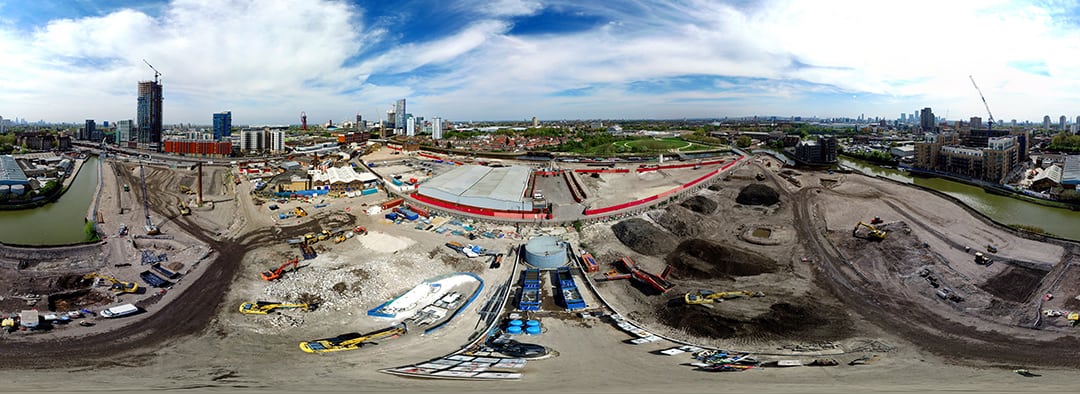Sugar House Island
Vastint UK


£65m

Stratford
Location & Overview
John F Hunt Regeneration undertook the role of principal contractor on the £75 million regeneration project in Stratford, London. The site had previously accommodated heavy industrial usage, their legacy comprising underground storage tanks, pipelines, ducts, pits, and soakaways in addition to a residual process plant associated with a former oil terminal, printing ink and tar works. Significant pollution issues were present, including dense non-aqueous phase liquids in the form of coal tar in soils, heavy and light hydrocarbons, solvents, and creosote in the underlying gravels. Site preparation, remediation, and infrastructure of 10 hectares of former industrial land, including former gas works, printing, and dye works.
Work, Challenges & Solutions
Remediation was undertaken in accordance with a strict construction programme, designed to allow the phased completion of development areas.
Installation of a steam injection system to reduce the viscosity of creosote contamination enabled the pollutant to be extracted from the underlying groundwater, whilst ensuring regulatory compliance.
Geotechnically stabilised materials were re-used in the highways works and as part of the pile mat construction, significantly reducing the requirement for imported recycled aggregates.
Treated materials meeting stringent remedial targets were placed within service corridors. Solvent, hydrocarbons, and PAH contamination was treated on-site using a combination of complex sorting, advanced bioremediation, and windrowing techniques. The petroleum hydrocarbon-impacted soils were then re-used to fill deep excavations once verified.
To satisfy planning conditions, site-wide remediation and verification under the current Part IIA framework were required, as was the Ecological protection works for Japanese Knotweed and Giant Hogweed.
A greater volume of asbestos was discovered within the made ground than was indicated in initial site investigations. As a result, the original strategy would have required the removal of 30,000m3 of asbestos-impacted soils from site to a licensed landfill and the importation of material to compensate.
The John F Hunt team had to find solutions to mitigate the potential risk, with materials re-used in a safe and sustainable manner on site, with full regulatory approval.
As a result, the Remedial Design was adapted to include revised re-use criteria for asbestos within soils. Implementing all relevant health, safety, and statutory requirements, impacted soils were excavated under controlled conditions under an ASB5 Notification to the HSE. Soils were then treated on site and verified for re-use at depth below a capping layer, in full accordance with the updated design.
The masterplan altered the levels dramatically across the site by approximately 4 meters. Innovative solutions were required with regard to materials management to address the change in levels and earthworks balance.
To overcome the shortfall in recycled aggregates, the Remedial Design was adapted to allow the stabilisation and re-use of geotechnically poor materials. The team were able to identify re-use locations for each material type through the innovative use of Building Information Modelling (BIM).
Extensive stakeholder and community engagement measures were necessary, with working practices and methodologies adapted due to our proximity to site neighbours, thus minimising the potential risk to human health and ensuring the protection of the adjacent controlled waters.
Our CCS score for the site was an exceptional 44/50, with an innovation score for the project of 8.2. Due to complex ground conditions and challenging engineering requirements, we implemented the following innovative solutions:
Remedial adaptions regarding asbestos in soils negated the need to remove 30,000m3 of impacted soils to landfill.
2,159 tonnes of CO2 were saved by retaining geotechnically poor material on site and importing aggregates to replace the shortfall 50,000m3 of material was treated using advanced bioremediation techniques for re-use in accordance with the remedial strategy. We saved approximately 5,300 unnecessary lorry movements and 1,000 tonnes of CO2.
The use of BIM enabled the continuous real-time management and placement of the soils, alongside continual stockpile management and tracking to ensure regulatory compliance for re-use of treated soils, including asbestos treatment. This approach ensured that swift regulatory approval was gained to enable prompt commencement of the construction phase.
Achievements
Award-winning: We successfully delivered the project, and the scheme won the Best Biodiversity Enhancement Award at the flagship Brownfield Briefing Awards.
We saved our client millions of pounds by adapting the remedial strategy regarding asbestos contamination, negating the removal of 30,000m3 of impacted soils to landfill.
By not needing to remove the geotechnically poor material from site and import aggregates to replace the shortfall, 5,300 unnecessary lorry movements and 2,159 tonnes of CO2 were saved.
7,000 litres of neat creosote was removed from the groundwater and approx. 50,000 m3 of soil was treated using sustainable techniques - making the project one of the largest remediation schemes in the UK.

